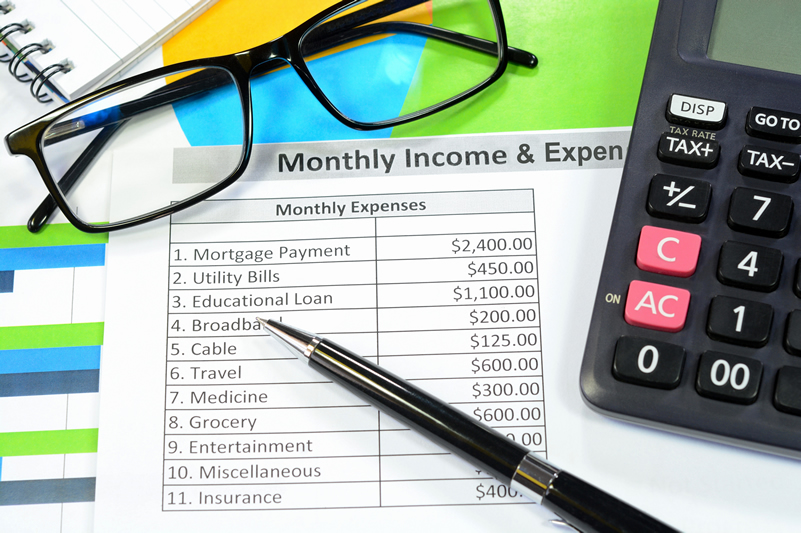
When trying to trim a monthly budget, most people don’t consider their fixed expenses. These recurring costs, which include mortgage payments, insurance premiums and subscription payments, are easy to budget and plan for since they generally remain constant throughout the year. While people tend to think there’s no way to lower fixed expenses, with a bit of effort and research, most of these costs can be reduced.
Here are five ways to trim your fixed expenses.
1. Consider a refinance
Mortgage payments take the biggest bite out of most monthly budgets. Fortunately, you can lower those payments by refinancing your mortgage to a lower interest rate. The refinance will cost you, but you can roll the closing costs and other fees into your refinance loan. Plus, the money you save each month should more than offset these costs. A refinance is an especially smart move to make in a falling-rates environment or if your credit has improved a lot since you originally opened your mortgage.
2. Lower your property taxes
Taxes may be inevitable, but they aren’t set in stone. You may be able to lower your property taxes by challenging your town’s assessment of your home. Each town will have its own guidelines to follow for this process, but ultimately you will agree to have your home reappraised in hopes of proving its value is less than the town’s assessment. This move can drastically lower your property tax bill; however, if you have made improvements to your home, it may be appraised at a higher value, which could raise your taxes.
3. Change your auto insurance policy
The Geico gecko and Progressive’s Flo, who love disrupting your favorite TV shows, actually have a point: You may be overpaying for your auto insurance policy.
If you’ve had the same policy for several years, speak to a company representative about lowering your monthly premiums. By highlighting your loyalty and having an excellent driving record, you may be able to get a lower quote. You can also consider increasing your deductible to net a lower monthly premium.
If your insurance company is not willing to work with you, it might be time to shop around for a provider that will. A few minutes on the phone can provide you with a significant monthly savings for a similar level of coverage. Once you have a lower quote in hand, you can choose to go back to your original provider and tell them you’re seriously considering a switch; they may change their mind about their previous lowest offer.
4. Consolidate your debts
If you’re carrying a number of outstanding debts, your minimum monthly payments can be a serious drain on your budget. Plus, thanks to the high interest rates you’re likely saddled with, you might be feeling like that debt is going nowhere.
Lucky for you, there is a way out. If you have multiple credit cards open, each with an outstanding balance, you might want to consider a balance transfer. This entails opening a new, no-interest credit card, and transferring all of your debts to this account. The no-interest period generally lasts up to 18 months. Going forward, you will only have one debt payment to make each month. Plus, the no-interest feature means you can make a serious dent in paying down that debt without half of your payment going toward interest.
Another way to consolidate debt is to take out a personal loan at Artesia Credit Union. Our personal loans will allow you to pay off all of your credit card debt at once. With interest rates starting at just 9.00% APR*, you’ll only need to make a single, affordable monthly payment until your loan is paid off.
5. Cut out subscriptions you don’t need
Another fixed expense most people mindlessly pay each month are subscriptions. Take some time to review your monthly subscriptions and weed out those you don’t really need. Below, we’ve listed some of the most commonly underused monthly payments:
- Gym membership. Are you really getting your money’s worth out of your gym membership? It may be cheaper to just pay for the classes you attend instead of a full membership. Or, if you have a favorite workout machine at the gym, consider purchasing it to use at home for a one-time cost that lets you to drop your gym membership.
- Cable. Why are you still paying for cable when you can stream your shows for less through services like Netflix and Hulu? If you don’t want to cut out cable entirely, consider downgrading to a cheaper plan that drops some of the premium channels you don’t watch much.
- Apps. How many apps are you signed up for? You may not even remember signing up for an upgraded version of an app you rarely use. A quick perusal of your monthly checking account statement or credit card bill can help you determine how much these subscriptions are costing you. Drop the apps you’re not using for more wiggle room in your monthly budget.
Your fixed monthly expenses are actually not as “fixed” as you may have thought. By taking a careful look at some of these costs, you can free up more of your monthly income for the things that really matter.
*APR refers to Annual Percentage Rate




